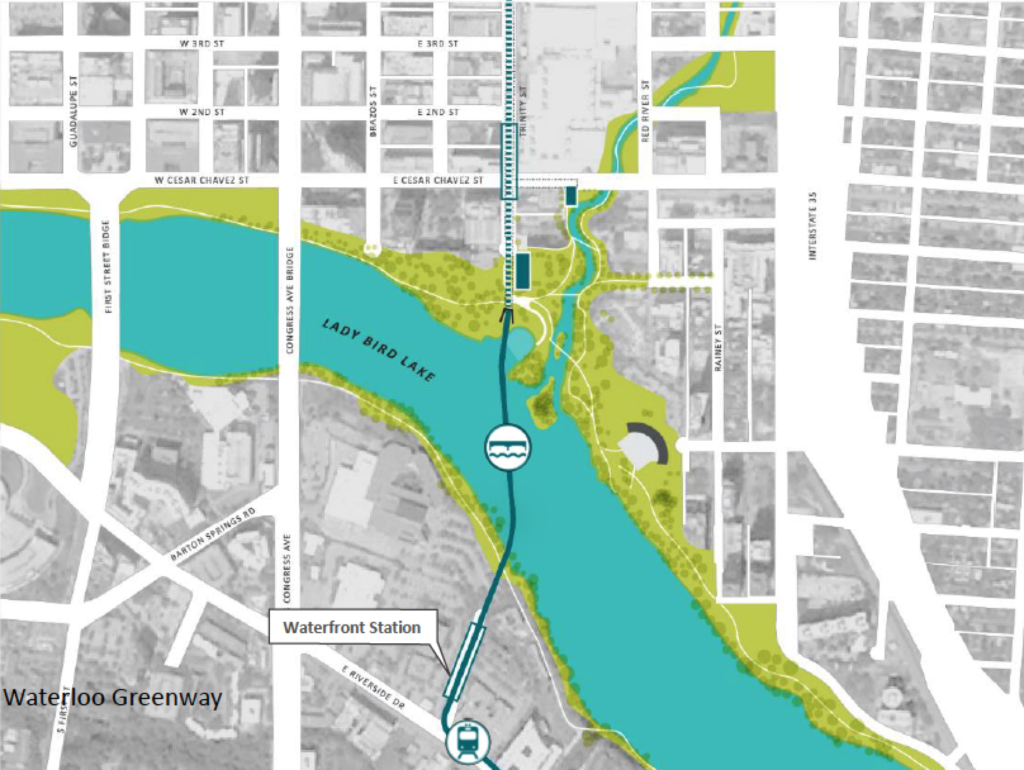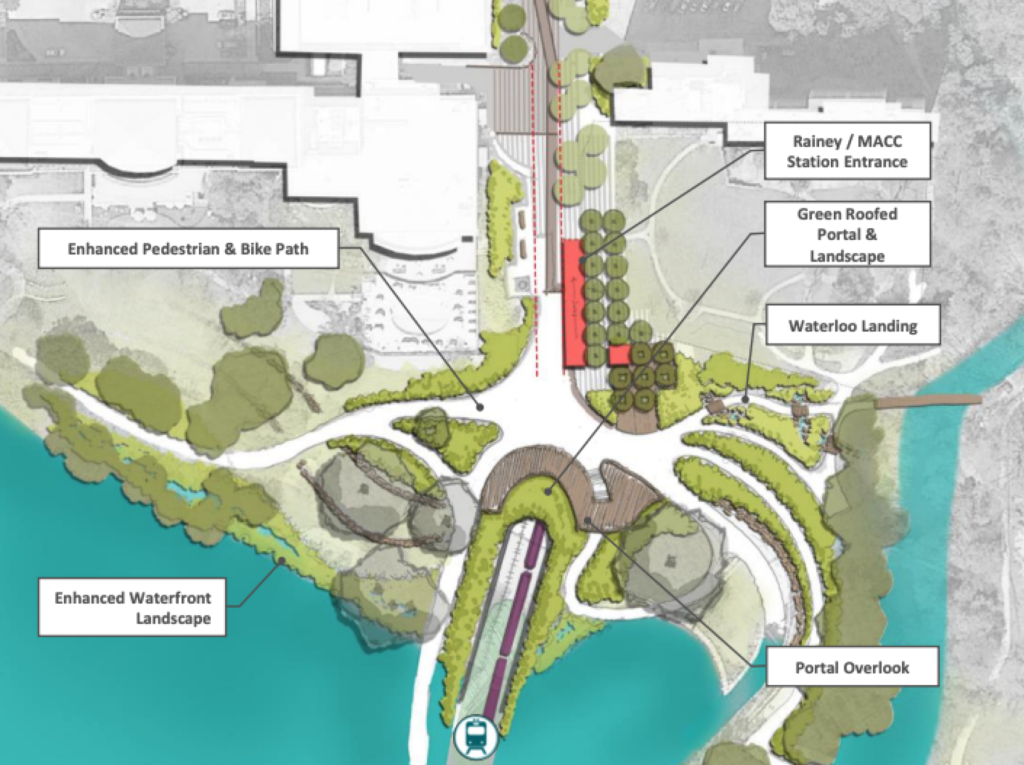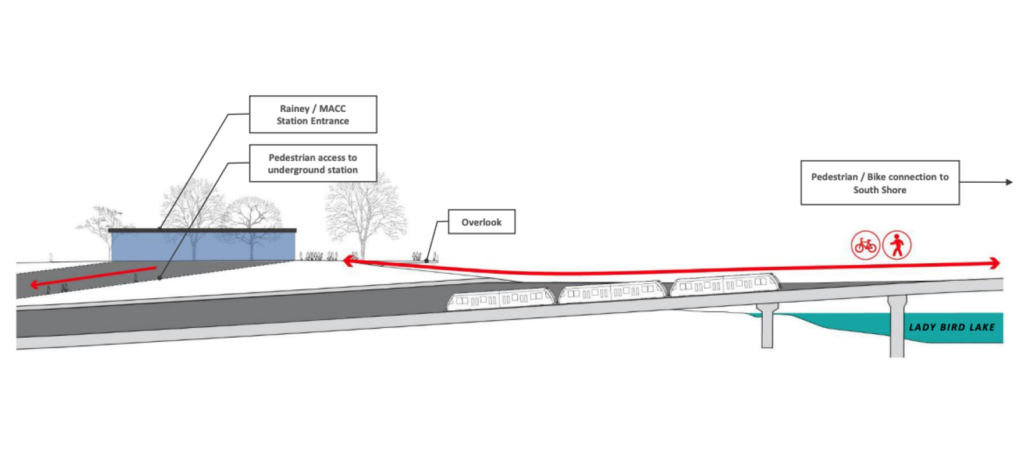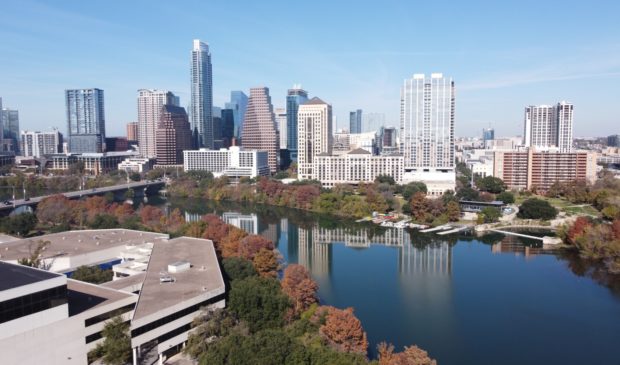Photo by Nathan Bernier/KUT. A light-rail bridge is planned for this section of Lady Bird Lake, just east of the Congress Avenue Bridge.
Should buses be allowed on a new light-rail bridge over Lady Bird Lake?
Thursday, December 9, 2021 by
Nathan Bernier, KUT Local officials overseeing Austin’s $7 billion expansion of public transit plan to launch an international competition to solicit designs for a light-rail bridge over Lady Bird Lake. Among the many questions swirling around the look and purpose of the structure, one has emerged as perhaps the most contentious: Should Capital Metro buses be allowed to cross the bridge?
The question has been a hot topic among close observers of the process and recently emerged at a public design workshop hosted by the Austin Transit Partnership, the government corporation created to oversee the Project Connect transit expansion.

On Tuesday, the debate over buses on the light-rail bridge spilled out at a contentious meeting of the city’s Urban Transportation Commission, a body that advises City Council.
“We mustn’t let the design of this new bridge further the oppressive and racist past of our city,” Commissioner Samuel Franco said, referring to Austin’s 1928 Master Plan, which forced Black residents to the city’s east side.
Franco argued that regular bus riders – almost two-thirds of whom are people of color, according to the Capital Metropolitan Transportation Authority – would be disadvantaged if buses were prohibited from using a dedicated bridge to access downtown Austin.
“All we’re hearing is, ‘No, we don’t want that.’ We haven’t even opened it up to see if (designers) can do that or not,” he said. “That is a grave injustice.”
ATP said the light-rail system aims to serve a diverse ridership, too. But the organization’s lead designer listed a number of concerns over allowing buses on a crossing intended exclusively for light rail, pedestrians and cyclists.
“That was not part of the planning leading up to the (Project Connect) referendum and certainly as part of our initial design phase,” said Peter Mullan, ATP’s chief of architecture and urban design.
In particular, he said, he wasn’t sure how buses could be incorporated in an underground tunnel on the north side of the lake because it’s so constrained.

This illustration shows a landscaped view of where the Blue Line will enter a tunnel portal on the north side of Lady Bird Lake. (Austin Transit Partnership)
“Weaving buses into that, I think, is going to be very challenging,” he said.
Experts and consultants advised ATP not to have light rail share tracks with other vehicles, Mullan said, because it could introduce the risk of a collision or obstruction.

A cross-section showing how the Blue Line would enter a tunnel on the north side of Lady Bird Lake after crossing the bridge. (Austin Transit Partnership)
Franco countered that Tilikum Crossing in Portland could be a model for a shared bridge. The bridge over the Willamette River, which opened in 2015, accommodates light rail, buses, streetcars, cyclists and pedestrians.
Mullan said the Tilikum Crossing bridge “is of a completely different scale” than the bridge planned for the Blue Line over Lady Bird Lake.
Some members of the Urban Transportation Commission were left unconvinced. They discussed the possibility of a vote at their next meeting urging Council to consider allowing design firms to figure out how to add bus capacity to the bridge.
ATP is planning to issue a request in January for engineering firms worldwide to compete for the contract to design the bridge. A decision over whether the bridge should allow buses would not have to be made until after those companies are selected, Mullan indicated.
Regardless of what happens with the Blue Line bridge, Capital Metro buses could get another priority crossing over Lady Bird Lake.
The city is considering whether to allow for dedicated bus lanes on the South First Street Bridge, Austin Transportation Department Assistant Director Anna Martin revealed at the commission’s meeting.
The idea had been put on hold pending design of the Orange Line, which is now planned to enter downtown from South Austin through a tunnel that would be dug just west of the South First Street Bridge.
“Now that the Orange Line plans are a little more clear, we’re reinvestigating if we should further those plans for the South First Street Bridge,” she said.
This story was produced as part of the Austin Monitor’s reporting partnership with KUT.
The Austin Monitor’s work is made possible by donations from the community. Though our reporting covers donors from time to time, we are careful to keep business and editorial efforts separate while maintaining transparency. A complete list of donors is available here, and our code of ethics is explained here.
You're a community leader
And we’re honored you look to us for serious, in-depth news. You know a strong community needs local and dedicated watchdog reporting. We’re here for you and that won’t change. Now will you take the powerful next step and support our nonprofit news organization?














